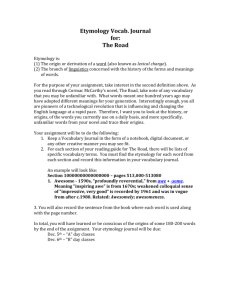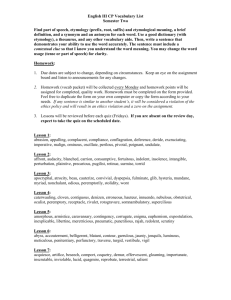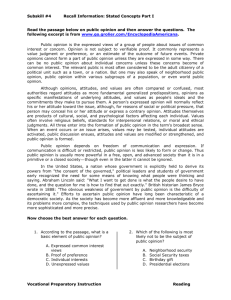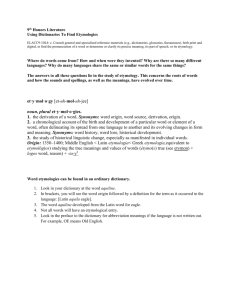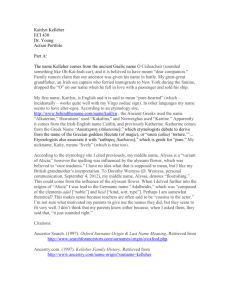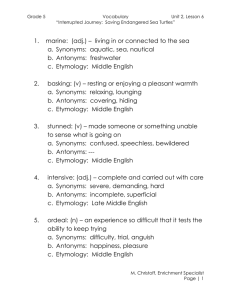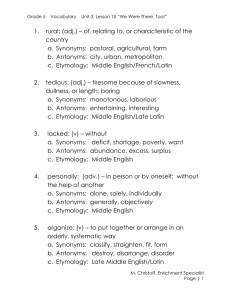Names: Nguyen`s Class Period: Work in your group to answer
advertisement
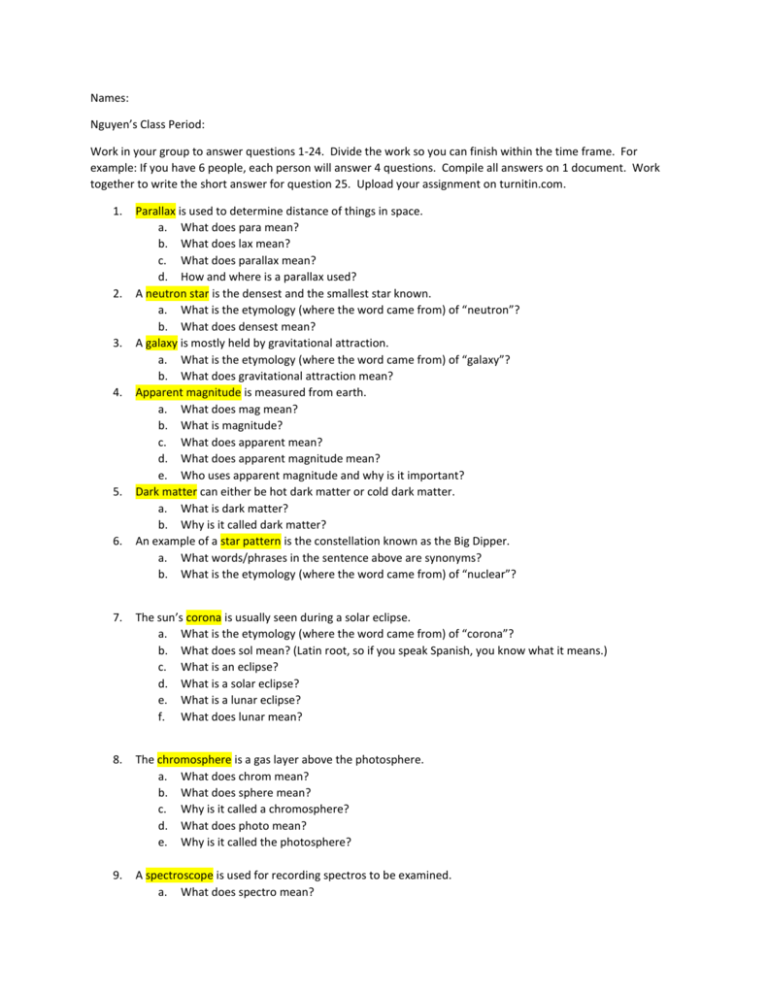
Names: Nguyen’s Class Period: Work in your group to answer questions 1-24. Divide the work so you can finish within the time frame. For example: If you have 6 people, each person will answer 4 questions. Compile all answers on 1 document. Work together to write the short answer for question 25. Upload your assignment on turnitin.com. 1. 2. 3. 4. 5. 6. Parallax is used to determine distance of things in space. a. What does para mean? b. What does lax mean? c. What does parallax mean? d. How and where is a parallax used? A neutron star is the densest and the smallest star known. a. What is the etymology (where the word came from) of “neutron”? b. What does densest mean? A galaxy is mostly held by gravitational attraction. a. What is the etymology (where the word came from) of “galaxy”? b. What does gravitational attraction mean? Apparent magnitude is measured from earth. a. What does mag mean? b. What is magnitude? c. What does apparent mean? d. What does apparent magnitude mean? e. Who uses apparent magnitude and why is it important? Dark matter can either be hot dark matter or cold dark matter. a. What is dark matter? b. Why is it called dark matter? An example of a star pattern is the constellation known as the Big Dipper. a. What words/phrases in the sentence above are synonyms? b. What is the etymology (where the word came from) of “nuclear”? 7. The sun’s corona is usually seen during a solar eclipse. a. What is the etymology (where the word came from) of “corona”? b. What does sol mean? (Latin root, so if you speak Spanish, you know what it means.) c. What is an eclipse? d. What is a solar eclipse? e. What is a lunar eclipse? f. What does lunar mean? 8. The chromosphere is a gas layer above the photosphere. a. What does chrom mean? b. What does sphere mean? c. Why is it called a chromosphere? d. What does photo mean? e. Why is it called the photosphere? 9. A spectroscope is used for recording spectros to be examined. a. What does spectro mean? b. c. What does scope mean? Why is it called a spectroscope? 10. The photosphere is the luminosity and heat a star has. a. What does lum/lumen mean? b. What other words contain the word root lum? 11. Nuclear fusion happens when helium and hydrogen react together to create the sun’s atmosphere. a. What is the etymology (where the word came from) of “nuclear”? b. List other words related to nuclear. c. What is the etymology (where the word came from) of “atmosphere”? d. What does atmosphere mean? e. Why is it called nuclear fusion? f. What is the importance (significance) of nuclear fusion? 12. The astronomical unit is equal to 149.6 million kilometers. a. What does astro mean? b. List other words with the root astro. c. What does kilo mean? d. What does meter mean? e. What’s a kilometer? 13. The H-R Diagram is the diagram that shows the luminosity level of stars. a. What is the etymology (where the word came from) of “diagram”? b. What is a diagram? c. What does H-R stand for? Where did the name H-R diagram come from? d. Why is a diagram showing the luminosity level of stars important? What’s it used for? (Why should we care about the luminosity level of stars?) 14. A planetary nebula is a ring shaped nebula, formed by shells of gas. a. What is the etymology (where the word came from) of “nebula”? b. What is a planetary nebula? c. What does “shells of gas” mean? 15. Convection zone is and outer layer or the sun that forms gas loops. a. Correct the sentence above. It does not make sense. b. What is the etymology (where the word came from) of “convection”? c. What is a gas loop? 16. The Doppler Shift is the change of sound or light emitted by and object. a. What is the etymology (where the word came from) of “Doppler”? b. What’s a shift? c. What does mit mean (emit)? d. What does emit mean? e. What things can cause a Doppler Shift? Can a person? 17. The Milky Way is the galaxy where earth is located. a. Why is it called “The Milky Way”? b. List other galaxies. 18. The radiative zone is a layer of a star where the energy is transported. a. What is the etymology (where the word came from) of “radiative”? b. What’s a zone? c. What does trans mean? d. e. What does port mean? What does transport mean? 19. One example of luminosity can be the sun. a. What does lum mean? b. List things that illuminate. c. Paraphrase the above sentence (#1) so a Kindergartener could understand it. 20. Many stars are able to become a black hole. a. What is a black hole? b. Why is it called a black hole? 21. When traveling to space, the time it takes from here to the destination, is measured in light years. a. Why is it called a light year? b. Why is time measured in light years in space? c. How does time in a light year compare to time in Houston, Texas? d. What’s a destination? 22. When the sun explodes it will be called a supernova. a. What does super mean? b. What does nova mean? c. Why is it called a supernova? d. Are there other supernovas? If so, list them. 23. A white dwarf is a star that is hot and is slowly cooling down. a. What is a dwarf? b. Why is it called a “white dwarf”? 24. A nebula is a cloud of gas and dust. a. What is the etymology (where the word came from) of “nebula”? b. Why is it called a nebula instead of a dust and gas cloud? 25. Write about what you’ve learned in this science unit using all these vocabulary words in a way that a nonscience expert (like me!) would be able to understand.
